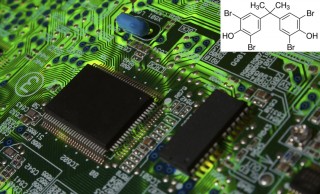Is the Flame Retardant, Tetrabromobisphenol A (TBBPA), a Reproductive or Developmental Toxicant?

Chemical Formula for TBBPA used in Electrical Circuit Boards
Tetrabromobisphenol A, or TBBPA, is a useful flame retardant used in a variety of consumer products, including electrical equipment and household furniture.
Organobromide flame retardants such as TBBPA are widely used due to their efficacy and in order to meet fire safety standards for products on the market, but concerns have been raised due to TBBPA's ability to leach into the environment and produce adverse effects on human health and ecosystems overall (Decherf and Demeneix, 2011).
TBBPA has been shown in vitro to bind to estrogen hormone receptors at high concentrations (Gosavi et al., 2013) and cause other effects on hormone sensitive parameters (Decherf and Demeneix, 2011). In 2004, TBBPA had an annual global production of more than 170 kilotons, though only 20-30% of the total volume produced was used as an additive flame retardant on material subject to environmental leaching (ECB, 2006).
Though the live animal toxicity database on TBBPA does not suggest that this flame retardant has any substantial impact on systemic effects, including endocrine function, the potential effects of TBBPA on developmental and reproductive functions have not been examined.
This recent article submitted to the journal Toxicology by Cope et al. (2015) studies the influence of TBBPA on reproductive and developmental parameters in Sprague-Dawley rats exposed orally at doses up to 1000 mg/kg of body weight daily in two separate, unpublished developmental and multi-generational studies, also examining endocrine function and behavioral, neurological and neuropathic functions in the offspring.
TBBPA was not found to be a developmental toxicant in rats, showing no signs of adult maternal toxicity or overt teratogenicity. Results from the multigenerational study showed a sole histopathologic alteration in the F2 generation with a thinning of the brain parietal cortex, though this was considered reversible and interpreted with caution, due to no other neurodevelopmental or neurofunctional deficits being noted.
Decreases in serum T4 in the thyroid were found with absences of concurrent changes in other thyroid hormones, such as T3 and TSH, leading the authors to conclude that this pattern of change has been seen with other xenobiotics in rodents and has not yet been seen in humans. The authors suggest that this is possibly due to a protein chaperone, thyroxine binding globulin or TBG, not found in rats and thus allowing humans to be more resistant to the effects of TBBPA on T4. No other effects were noted for TBBPA in the multi-generational study.
Contact Information
Patricia Nance
Science Outreach & Initiatives Leader
nance@tera.org
Phone: 513-542-7475 x25
Media Contact
More Information:
http://www.tera.orgAll latest news from the category: Life Sciences and Chemistry
Articles and reports from the Life Sciences and chemistry area deal with applied and basic research into modern biology, chemistry and human medicine.
Valuable information can be found on a range of life sciences fields including bacteriology, biochemistry, bionics, bioinformatics, biophysics, biotechnology, genetics, geobotany, human biology, marine biology, microbiology, molecular biology, cellular biology, zoology, bioinorganic chemistry, microchemistry and environmental chemistry.
Newest articles

Properties of new materials for microchips
… can now be measured well. Reseachers of Delft University of Technology demonstrated measuring performance properties of ultrathin silicon membranes. Making ever smaller and more powerful chips requires new ultrathin…

Floating solar’s potential
… to support sustainable development by addressing climate, water, and energy goals holistically. A new study published this week in Nature Energy raises the potential for floating solar photovoltaics (FPV)…

Skyrmions move at record speeds
… a step towards the computing of the future. An international research team led by scientists from the CNRS1 has discovered that the magnetic nanobubbles2 known as skyrmions can be…





















